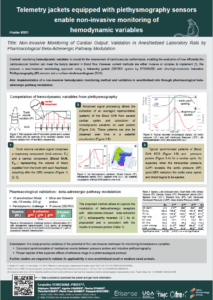Leandro Fontana Pires1,2, Agathe Cambier2, Stéphane Tanguy1, Charles Eynard2, Timothé Flenet2, Pierre-Yves Gumery1, François Boucher1
¹ PRETA TEAM, TIMC IMAG, 38706 La Tronche CEDEX, France;
² R&D, ETISENSE SAS, 60 avenue Rockefeller, 69008 LYON, France
Safety Pharmacology Society Annual Meeting, 2023
Abstract
Cardiac output (CO) is an essential component of hemodynamics, allowing to assess how efficiently the cardiovascular function can meet the body’s demand in blood flow. However, current available methods for measuring CO are either invasive or complex to implement. Hence, the aim of the study was to evaluate the capability of a non-invasive approach utilizing inductive plethysmography (IP) for estimating CO. By employing a jacketed external telemetry (DECRO® system by ETISENSE), embedding ultra high resolution IP sensors, small trunk volume variations, called “Blood Shift”, corresponding to the displacement of blood in the organism are measured. This represents an estimate of stroke volume (SV❜), which allows CO estimation (CO❜=SV❜×HR), since the heart rate (HR) can be derived from the external electrocardiogram (ECG) integrated into the jacket.
A pharmacological protocol with a hemodynamic challenge was performed in 10 anesthetized (2%/2.5% isoflurane) male Wistar rats (10 weeks, 355 g) under spontaneous ventilation. The animals were equipped with the jacke t and surface electrodes (under the jacket) for ECG recording. Left ventricular pressure (LV) and arterial pressure (AP) were assessed using a Millar and Edwards probe, respectively. The protocol consisted of continuous intravenous (i.v.) infusions of 12.5 µg/mL of dobutamine (beta stimulant) at ascending infusion rates of 4 6 and 8 mL/h. Pharmacological recovery was achieved by injection of 3 µmol/kg (1 mL/kg i.v) of dl propranolol (non selective beta blocker). Developed ventricular pressure (LVP) and mean arterial pressure (MAP) were calculated from LV and AP signals, respectively . Blood shift was extracted from the IP signal, and SV❜ was estimated using an average cardiac pattern derived from multiple cycles. CO❜ was then estimated throughout the entire duration of the protocol and statistical significance of variations was assessed.
A significant increase (p<0.01) in LVP, HR and CO❜, along with a significant decrease (p<0.01) in MAP were observed between the baseline and dobutamine infusion rates (6 and 8 mL/h), while a significant decrease (p<0.01) was observed in all variables (LVP, MAP, CO❜ and HR) between the baseline and the
recovery phase (dl-propranolol).
These results provide evidence that IP has the capability to capture the expected effects of reference drugs. Further studies are needed to validate this technique in non anesthetized small or medium size animals.

